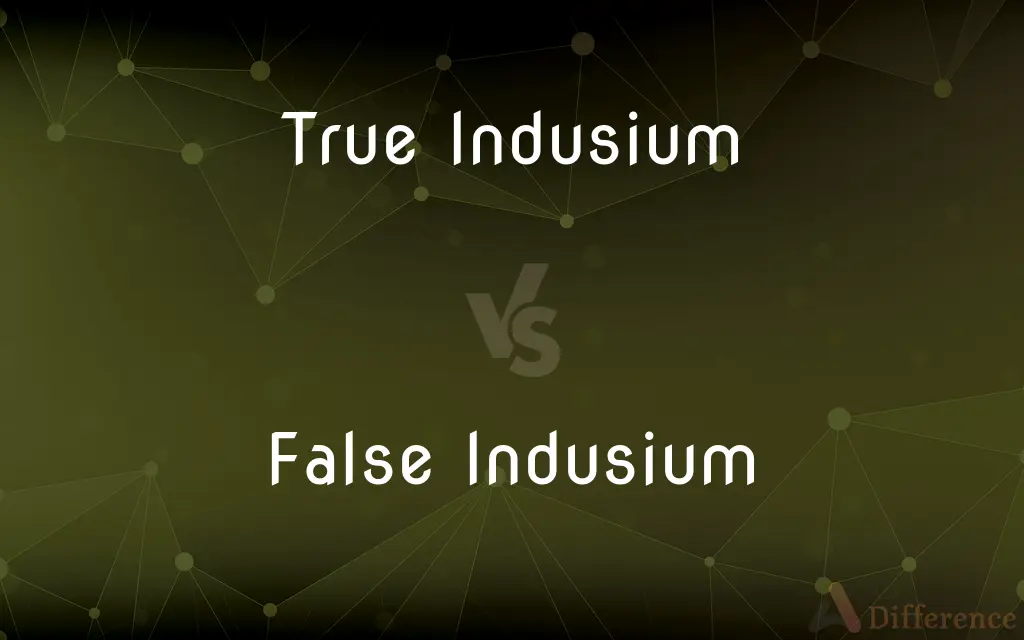True Indusium vs. False Indusium — What's the Difference?
By Tayyaba Rehman — Published on November 14, 2023
True Indusium is a protective tissue covering fern spores, while False Indusium is the leaf margin rolled over the sori.

Difference Between True Indusium and False Indusium
Table of Contents
ADVERTISEMENT
Key Differences
The term True Indusium refers to a specialized outgrowth on the upper surface of a fern frond that covers and protects the developing spores. It originates from the same tissue as the rest of the leaf, ensuring that its structure and function are consistent. On the other hand, False Indusium is not a separate specialized structure. Instead, it is a part of the leaf margin that curls or folds over to protect the sori, which contains the spores.
The distinction between True Indusium and False Indusium is essential because it highlights the adaptive strategies of ferns to protect their reproductive structures. While True Indusium has evolved as a distinct tissue for protection, False Indusium achieves the same goal without any specialized growth.
Another point of differentiation is in the appearance. True Indusium can vary in shape and size depending on the fern species, while False Indusium is always derived from the leaf's edge. Thus, when studying ferns, the presence of True Indusium or False Indusium can be a significant clue in species identification.
Comparison Chart
Origin
Specialized outgrowth from frond's surface
Leaf margin that curls over the sori
Structure
Can vary in shape and size
Always derived from the leaf's edge
ADVERTISEMENT
Function
Protects developing spores
Protects the sori containing spores
Evolution
Distinct tissue for protection
Achieves protection without specialized growth
Identification
Important for species classification
Used as a secondary identifying feature
Compare with Definitions
True Indusium
True Indusium is the shield-like structure on some ferns.
The True Indusium is evident on the upper side of the fern's frond.
False Indusium
False Indusium offers protection without specialized growth.
The fern utilized its False Indusium to protect its spores.
True Indusium
True Indusium is a protective flap on ferns covering spores.
The True Indusium on the fern effectively shielded the young spores from environmental damage.
False Indusium
False Indusium is derived from the leaf's edge in ferns.
The botanist noted the presence of a False Indusium in the fern specimen.
True Indusium
True Indusium is an outgrowth on a fern's upper surface.
Observing under a microscope, the botanist identified the True Indusium's distinct structure.
False Indusium
False Indusium shields the sori in certain fern species.
Relying on its False Indusium, the fern ensured its sori were safe from predators.
True Indusium
True Indusium is the tissue protecting fern's reproductive structures.
The True Indusium's presence ensures the safety of the fern's spores.
False Indusium
False Indusium is the leaf margin of ferns rolled over sori.
The False Indusium provided a natural cover for the sori underneath.
True Indusium
True Indusium refers to the specialized tissue in ferns.
Fern species can sometimes be identified by the shape of their True Indusium.
False Indusium
False Indusium is not a distinct structure but a curled leaf edge.
On closer examination, what appeared to be an outgrowth was actually a False Indusium.
Common Curiosities
What is the main function of the True Indusium?
The True Indusium's primary function is to protect the developing spores in ferns.
Can the presence of False Indusium alone identify a fern species?
No, while it can be a clue, other characteristics are also considered for species identification.
How does False Indusium differ from True Indusium in origin?
False Indusium is the curled leaf margin, while True Indusium is a specialized outgrowth from the frond's surface.
Can the presence of True Indusium help in fern identification?
Yes, the presence and shape of True Indusium can be a significant clue in identifying fern species.
Which offers a more direct protection strategy, True Indusium or False Indusium?
Both offer protective strategies; True Indusium through specialized growth and False Indusium through the leaf margin.
Does False Indusium vary in shape like True Indusium?
No, False Indusium is always derived from the leaf's edge, while True Indusium can vary in shape.
How is True Indusium beneficial for fern reproduction?
True Indusium protects the developing spores, ensuring they mature without damage.
Is False Indusium a specialized structure?
No, False Indusium is not a specialized structure; it's the leaf margin that curls over the sori.
Which is more evolutionary advanced, True Indusium or False Indusium?
Both are adaptive strategies of ferns, neither is necessarily more advanced than the other.
Do both True Indusium and False Indusium exist on the same fern?
It's uncommon, but some fern species might exhibit both features.
Is True Indusium found on all ferns?
No, True Indusium is not found on all ferns; it varies with species.
Which is more common in fern species, True Indusium or False Indusium?
The presence of either structure varies among fern species; neither is universally more common.
Is the primary purpose of False Indusium to protect the sori?
Yes, the primary purpose of False Indusium is to protect the sori containing spores.
How can one visually differentiate between True Indusium and False Indusium?
True Indusium appears as a distinct protective flap, while False Indusium is the leaf margin curled over the sori.
Are there any fern species without either True or False Indusium?
Yes, some fern species might lack both structures.
Share Your Discovery

Previous Comparison
Winners vs. Losers
Next Comparison
Unit Plan vs. Lesson PlanAuthor Spotlight
Written by
Tayyaba RehmanTayyaba Rehman is a distinguished writer, currently serving as a primary contributor to askdifference.com. As a researcher in semantics and etymology, Tayyaba's passion for the complexity of languages and their distinctions has found a perfect home on the platform. Tayyaba delves into the intricacies of language, distinguishing between commonly confused words and phrases, thereby providing clarity for readers worldwide.
















































